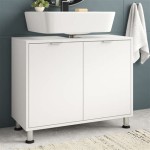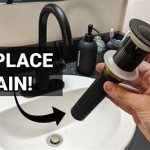Cleaning Out Bathroom Sink Trap: A Detailed Guide
The bathroom sink trap, also known as a P-trap, is a curved section of plumbing located beneath the sink basin. Its primary function is to trap debris and prevent sewer gases from entering the living space. Over time, hair, soap scum, toothpaste, and other materials accumulate within the trap, leading to clogs and slow drainage. Regular cleaning of the bathroom sink trap is essential for maintaining optimal plumbing performance and preventing unpleasant odors. Neglecting this maintenance task can result in complete blockage, requiring more extensive and costly repairs. This article provides a comprehensive guide to cleaning out a bathroom sink trap, covering necessary tools, step-by-step instructions, and preventative measures.
Understanding the Importance of Cleaning
The P-trap’s curved design creates a water seal that blocks sewer gases from rising through the drainpipe and into the bathroom. This water seal also catches solid debris that would otherwise flow further down the drain system, potentially causing blockages in the main plumbing lines. As these solid materials accumulate, they restrict water flow, leading to slow drainage and, eventually, a complete blockage. Furthermore, the decomposing organic matter trapped within the P-trap can generate foul odors that permeate the bathroom. Regular cleaning removes this accumulated debris, restoring proper drainage and eliminating unpleasant smells. Preventing a complete blockage is significantly easier and less expensive than dealing with the consequences of a fully clogged drain.
Beyond simply preventing clogs, cleaning the bathroom sink trap contributes to the overall hygiene of the bathroom. The trap can harbor bacteria and mold, especially in a warm, humid environment. Regular cleaning helps to reduce the presence of these microorganisms, promoting a healthier living space. This is particularly important for individuals with allergies or respiratory sensitivities, as mold and bacteria can exacerbate these conditions. Therefore, cleaning the sink trap is not just about maintaining plumbing functionality but also about fostering a cleaner and healthier bathroom environment.
Ignoring a slow-draining sink can lead to more severe plumbing issues. The buildup of pressure due to a blockage can potentially damage pipes and connections, resulting in leaks. These leaks can cause water damage to the surrounding cabinets, flooring, and even walls. Addressing drainage issues promptly by cleaning the sink trap can prevent costly repairs associated with water damage and plumbing failures. Proactive maintenance is always more cost-effective than reactive repairs.
Tools and Materials Required for the Job
Before embarking on the cleaning process, gathering the necessary tools and materials is crucial for a smooth and efficient experience. The following items are typically required:
*Adjustable Wrench or Pliers:
These tools are used to loosen and tighten the slip nuts connecting the P-trap components. *Bucket or Container:
This is essential for catching the water and debris that will be released from the trap. A shallow bucket is generally easier to position under the sink. *Plumber's Tape (Teflon Tape):
This tape is used to reseal the connections after cleaning, ensuring a watertight seal. *Gloves:
Wearing gloves protects hands from bacteria and grime encountered during the cleaning process. *Old Towels or Rags:
These are useful for cleaning up any spills or leaks. *Screwdriver (Optional):
A screwdriver might be needed if the trap has a cleanout plug. *Wire Coat Hanger or Drain Snake (Optional):
These tools can be used to dislodge stubborn clogs that are not easily flushed out. *Safety Glasses (Optional):
Safety glasses provide protection against splashes and debris.Having all these items readily available before starting the cleaning process minimizes interruptions and ensures a more efficient workflow. The type of wrench will depend on the size and type of nuts used in the plumbing under the sink. If unsure, an adjustable wrench is a versatile option that can accommodate different sizes.
Step-by-Step Cleaning Instructions
The following steps outline the process for cleaning a bathroom sink trap:
1.Preparation:
Begin by placing the bucket or container directly under the P-trap to catch the water and debris. Position the towels or rags around the work area to protect the surrounding surfaces from spills. 2.Loosening the Slip Nuts:
Using the adjustable wrench or pliers, carefully loosen the slip nuts at both ends of the P-trap. It is important to loosen the nuts gradually and evenly to prevent damage to the pipes. Avoid overtightening or stripping the threads on the nuts. 3.Removing the P-Trap:
Once the slip nuts are sufficiently loosened, carefully detach the P-trap from the drainpipes. Tilt the P-trap to allow the water and debris to drain into the bucket. Be prepared for a potentially unpleasant odor during this step. 4.Cleaning the P-Trap:
After removing the P-trap, thoroughly clean its interior. Rinse it with water to remove any loose debris. For stubborn clogs, use a wire coat hanger or drain snake to dislodge the blockage. Ensure that the entire P-trap is free of any accumulated material. Pay close attention to the curved section, as this is where most of the debris tends to accumulate. 5.Cleaning the Drain Pipes:
Inspect the drain pipes extending from the sink and the wall for any signs of buildup or blockage. Use a wire coat hanger or drain snake to clear any obstructions in these pipes. Flush the pipes with water to ensure they are clear of debris. 6.Reassembling the P-Trap:
Once all the components are clean, reassemble the P-trap. Align the P-trap with the drain pipes and tighten the slip nuts by hand. Then, use the adjustable wrench or pliers to tighten the nuts further, but avoid overtightening them. Apply plumber's tape to the threads of the drain pipes before reattaching the P-trap to ensure a watertight seal. Wrap the tape in the direction of the threads to ensure a secure seal. 7.Testing for Leaks:
After reassembling the P-trap, turn on the faucet and let the water run for a few minutes. Check for any leaks around the slip nut connections. If leaks are detected, tighten the nuts slightly or reapply plumber's tape to the threads. It is important to address any leaks immediately to prevent water damage. 8.Final Cleanup:
Once the P-trap is leak-free, dispose of the collected water and debris properly. Clean up any spills or messes in the work area. Wash the hands thoroughly with soap and water.If the sink trap has a cleanout plug, located at the lowest point of the U-bend, this can be unscrewed to drain the trap. Have a bucket underneath to catch the water, and then use a small brush or tool to remove any debris within. Ensure the rubber O-ring on the plug is in good condition before re-tightening it; if it is damaged, replace it to prevent leaks.
Preventative Measures to Minimize Clogging
Implementing preventative measures can significantly reduce the frequency of sink trap cleaning and minimize the risk of clogs. One simple measure is to install a mesh screen or strainer in the sink drain to catch hair and other debris. Regularly cleaning this screen prevents these materials from entering the drainpipe and accumulating in the P-trap. This small investment can save time and effort in the long run.
Another effective strategy is to avoid pouring grease, oil, or food scraps down the drain. These substances can solidify in the pipes, creating a sticky residue that attracts other debris and leads to blockages. Instead, dispose of grease and oil in the trash or recycle them properly. Food scraps should be composted or discarded in the garbage. Minimizing the amount of grease, oil, and food scraps that enter the drain system significantly reduces the likelihood of clogs.
Flushing the drain with hot water after each use can also help to prevent the buildup of soap scum and other materials. Hot water helps to dissolve these substances and flush them down the drain before they have a chance to solidify. Running hot water for a minute or two after each use is a simple and effective way to maintain a clean drainpipe. This is particularly beneficial after activities that generate a lot of soap scum, such as shaving or washing hands with bar soap.
Periodically flushing the drain with a mixture of baking soda and vinegar can also help to break down buildup and freshen the drain. Pour about a cup of baking soda down the drain, followed by a cup of vinegar. Let the mixture fizz for about 30 minutes, then flush with hot water. This natural cleaning solution can help to dissolve grease, soap scum, and other debris, leaving the drain clean and fresh. This method is particularly effective for removing odors emanating from the drain.
Regularly monitoring the sink's drainage speed is also a good preventative measure. If the water begins to drain more slowly than usual, it is a sign that a clog is starting to form. Addressing the issue promptly by cleaning the sink trap or using a drain snake can prevent the clog from becoming more severe. Early intervention is key to maintaining optimal drainage and preventing costly plumbing repairs.

How To Unclog Clean A Bathroom Sink Drain 3 Methods

How To Unclog A Sink The Right Way

How To Clean A P Trap Or U Bend 10 Steps With Pictures

How To Unclog A Bathroom Sink Hana S Happy Home

Clog Fix Clean Out P Trap Bathroom Sink Drain

How Often Should I Clean My Drains At Home

How To Clean A Bathroom Sink Drain

3 Ways To Clean A Sink Trap Wikihow

How To Clean Bathroom Drains Unclog Your Shower And Sink

How To Clean A Clogged Sink Remove Stopper
Related Posts







